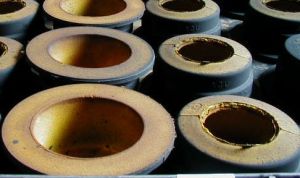DeLavaud process
The deLavaud process is a method by which molten iron is introduced into a spinning mold to produce fixed lengths of pipe at much greated speeds than possible with other methods. Created in 1921 by a Brazilian named Dimitri Sensaud deLavaud, the process was to revolutionize iron pipe manufacturing.
Process
In the deLavaud process a caster consists of a spinning steel mold surrounded by a water jacket or water sprays. A ladle and trough arrangement is used to deliver molten iron to the caster. Either the caster or ladle and trough will be on a rail carriage or other movable platform.
Iron is introduced into the caster at the bell (or joint) end of the mold by means of the trough which extends the length of the mold. The iron is poured from the ladle into a chute on the end of the trough. Once the bell is filled with iron either the caster or ladle and trough will begin to move. In this way, the end of the trough does not stay in one spot on the mold but continues to deliver iron to the entire length of the mold until the spigot end is reached and the iron flow is stopped. Centrifugal force causes the iron to cling to the inner surface of the mold where it solidifies into a seamless pipe.
The joint is created by means of a resin coated sand core of the proper size and shape for the mold. This core prevents iron from running out the end of the mold and provides the proper dimensions to accept the spigot (non-shaped) end of a pipe.
The steel mold is treated in various ways to increase adhesion of the iron during the casting process. The mold is usually peened to produce a dimpled pattern which increases surface firction during during casting, and also extends the life of the mold by dispersing thermal shock. Additionally this peening pattern acts as an anchor to hold various dry spray inoculants that are normally applied to the mold before casting. A variation on the process uses a thicker wet spray inoculant on the mold surface and dispenses with the peen pattern.
Images


